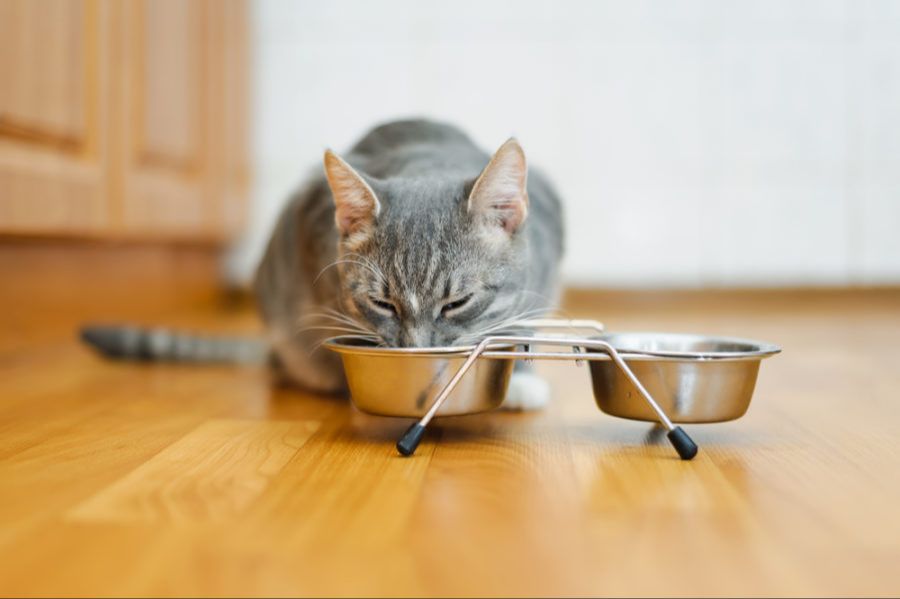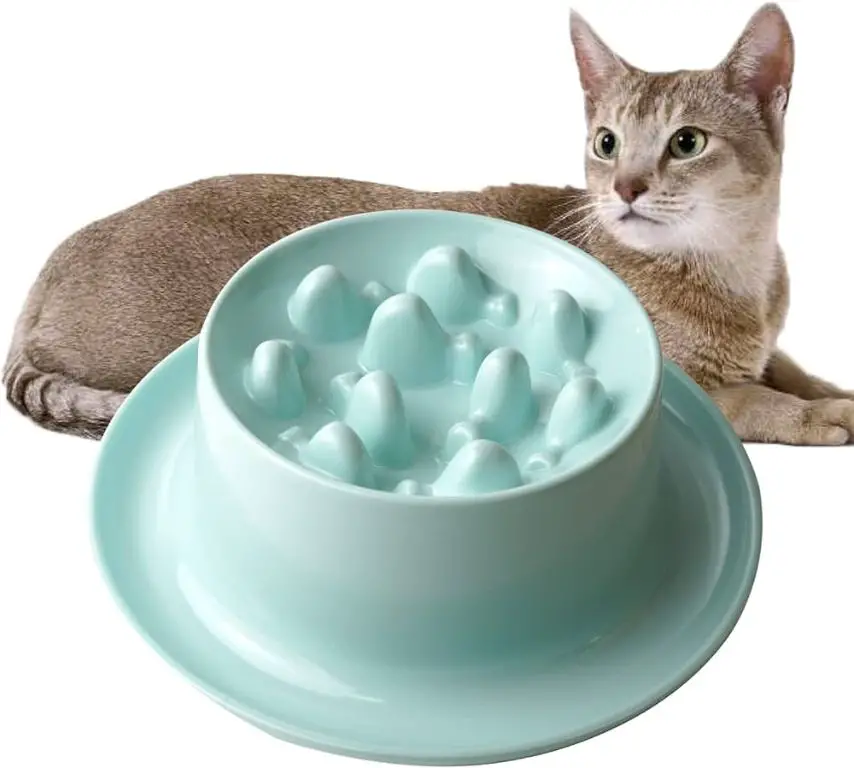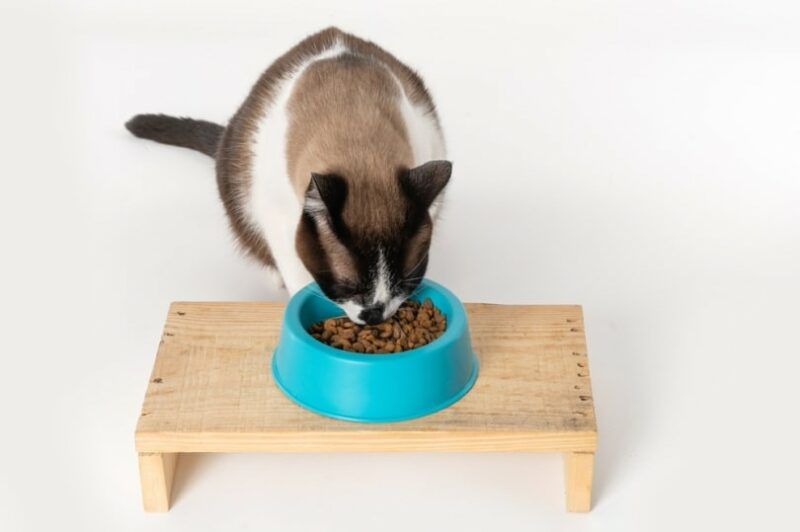Elevated bowls are sometimes recommended for cats to help them eat and drink in a more natural and comfortable posture. In the wild, cats don’t eat from bowls on the ground. They eat their prey from an elevated position. Eating from the floor can cause muscle strain and discomfort. Elevated bowls allow cats to eat in a more upright, relaxed position that puts less pressure on their neck and spine.

Veterinarians and cat experts often suggest using raised bowls to help prevent issues like vomiting, bloat, and megaesophagus. The proper body alignment from elevated bowls also aids digestion. Older cats or those with mobility issues can benefit from elevated bowls as well. While not necessary for all cats, elevated bowls provide posture and health advantages that make them a recommended option for many cats.
Proper Posture While Eating
When cats eat food placed on the ground, they naturally lower their head and neck into a hunched posture to reach the food. This unnatural crouching position twists the cat’s esophagus and applies pressure on their neck and spine over time (Source). Elevated cat food bowls allow cats to maintain proper posture while eating with their head and neck upright. This reduces strain on their spine and improves comfort. Cats naturally eat with an upright head and neck posture when accessing food in trees or other elevated places. Raised cat bowls mimic this natural stance.
Reducing Vomiting
One of the main reasons cat owners choose elevated bowls is to reduce vomiting after meals. When cats eat from bowls placed on the floor, they often ingest air while gulping down food. This can lead to indigestion, bloating, and vomiting of undigested food shortly after eating. Elevated bowls change the angle at which cats eat, allowing gravity to pull the food straight into the stomach rather than the airway. This helps reduce air intake and subsequent vomiting.

According to veterinarian Dr. Ivana Crnec (source), elevated bowls can reduce vomiting in some cats, especially those with megaesophagus, a condition where the esophagus loses muscle tone. However, results vary from cat to cat. Some cats may still vomit frequently despite using elevated bowls. Owners should monitor their cat’s response and consider other factors like eating speed and stress level.
Overall, elevated bowls can be a helpful tool for reducing vomiting after meals in susceptible cats. However, they may not be effective for all felines. Cat owners should consult their veterinarian to determine if using elevated bowls could benefit their individual cat.
Preventing Bloat
Bloat is a life-threatening condition where the stomach becomes enlarged with gas and fluid. It can occur in some large, deep-chested dog breeds like Great Danes, German Shepherds, and Dobermans. Bloat can happen when dogs eat too quickly, exercise after eating, or have underlying health issues.
Some pet owners believe using elevated dog bowls can help prevent bloat by slowing down a dog’s eating and making swallowing easier. However, research does not support this and suggests elevated bowls may actually increase bloat risk. One study found large breed dogs fed from an elevated bowl were significantly more likely to develop bloat.
Instead of using elevated bowls, other steps like eating multiple smaller meals per day, not exercising for at least an hour after eating, and getting regular vet checkups may help reduce bloat risk. For susceptible breeds, a preventive gastropexy surgery is the most effective way to prevent bloat from occurring.
Facilitating Digestion
One potential benefit of using elevated cat bowls is to facilitate digestion. When cats eat from bowls placed on the floor, they often swallow larger pieces of food and gulps of air. This can lead to indigestion, bloating, and vomiting. Eating from an elevated bowl allows gravity to help move food through the digestive tract more easily (https://www.pawaii.com/blogs/blog/should-you-buy-an-raised-cat-bowl).

Elevated bowls bring a cat’s food closer to shoulder level, promoting a natural upright eating posture. This allows cats to chew food more thoroughly before swallowing. By reducing the amount of air gulped while eating, elevated bowls can help prevent vomiting and gas (https://thekindpet.com/blogs/blog/5-benefits-of-raised-cat-food-bowls). The improved digestion from elevated bowls may be especially beneficial for cats prone to vomiting, gas, or bloating issues.
However, some experts argue elevated bowls do not significantly impact digestion in most cats. Proper chewing and slowed eating are more important factors. Owners should monitor their cat’s eating habits and consult a vet if digestion problems persist (https://www.petsradar.com/advice/should-i-elevate-my-cats-food-bowl).
Managing Megaesophagus
Megaesophagus is a disorder where the esophagus becomes dilated and does not function properly to move food into the stomach. This can make eating and digesting food very difficult for cats.
Elevated cat bowls can greatly benefit cats suffering from megaesophagus. When cats eat from bowls placed on the floor, they have to work against gravity to swallow their food. Gravity causes food to fall back down the enlarged esophagus instead of moving into the stomach.
With elevated bowls, gravity can work in the cat’s favor. Raising the food to mouth level or higher allows the food to move downwards with the help of gravity. This makes swallowing much easier for cats with megaesophagus. According to one cat owner, “The feeder was $12 on Amazon and it works great. Honestly, you can use anything as long as the food is elevated” (Source).
The optimal height of an elevated bowl depends on the individual cat. Generally, it should be high enough that the cat’s head and neck are level or pointed slightly downward when eating. This uses gravity to move food into the stomach instead of letting it fall back into the esophagus. Elevated bowls improve quality of life for cats with megaesophagus.
Minimizing Stress
Elevated cat bowls can help reduce stress for cats during mealtimes in a few key ways. According to Necoichi, elevated bowls keep food centered, making it easier for cats to eat without having to strain their necks. This prevents whisker and neck fatigue.
Additionally, elevated bowls allow cats to eat in a more natural upright position. When cats eat from bowls placed on the floor, they have to bend down awkwardly. This unnatural posture while eating can cause stress on their spines and necks. Elevated bowls bring food closer to the cat’s face, so they don’t have to crane their necks down.
By removing physical strain during meals, elevated bowls create a more relaxing and comfortable eating experience for cats. The reduction in fatigue and tension makes mealtimes less stressful for feline friends.
Accommodating Age
As cats get older, elevated bowls can provide several benefits. Senior cats often suffer from arthritis and joint pain which can make bending down to floor-level bowls uncomfortable. Elevated bowls allow older cats to access their food and water without excessive bending or stretching.
Elevated bowls also help senior cats who have lost muscle mass and strength in their necks. Drinking and eating from bowls on the floor can be difficult for senior cats with muscle deterioration. Raising bowls to chest level accommodates limited mobility and makes mealtimes less of a struggle.
Additionally, elevated bowls aid digestion in senior cats who may experience impaired esophageal sphincter function. Keeping food and water bowls elevated puts less pressure on the esophagus and allows gravity to help move food down into the stomach.
According to this source, elevated bowls reduce strain for aging cats, allowing them to eat comfortably without excessive bending or stretching. The ergonomic design supports senior cats’ changing physical needs.
Considering the Downsides
While elevated bowls can provide benefits for some cats, they may not be advisable in every situation. Here are some considerations on when elevated bowls may not be the best option:

Kittens and cats with mobility issues may have trouble accessing elevated bowls, leading to frustration or inability to eat properly. For very young or disabled cats, keeping bowls low to the ground is likely best.
Fast eaters can suffer from even more air intake and subsequent vomiting or bloating when gobbling food from an elevated bowl. For these cats, a slow feed bowl may be better than an elevated bowl.
Cats with a tendency towards chin acne or feline acne on the chin and around the mouth may find this condition exacerbated by having the face close to an elevated bowl while eating. A lower bowl may help improve air circulation and prevent bacterial buildup.
Elevated bowls are not necessary for cats who do not display issues with posture, vomiting, or digestion. The added height may disrupt their usual feeding routine. Sticking with a conventional bowl is fine if there are no problems to address.
As with any change, cats may resist switching to an elevated bowl at first. Gradual introduction and positive reinforcement can help them adjust. But some cats may refuse elevated bowls long-term.
While elevated bowls have benefits in many cases, they are not a cure-all solution. Considering the individual cat’s needs and monitoring their adjustment is important.
Conclusion
Elevated bowls can offer significant benefits for some cats. Older cats or cats with medical conditions like megaesophagus may benefit from elevated bowls to aid digestion and reduce vomiting. Elevated bowls can also help encourage proper posture and eating habits. However, elevated bowls are not necessarily recommended for all cats. Healthy cats without swallowing difficulties or joint issues may do fine with bowls placed on the floor. Cats should be monitored when transitioning to elevated bowls, as some may try to eat too quickly. Owners should assess their individual cat’s needs and age to determine if an elevated bowl is advisable. For cats exhibiting gagging, regurgitation, or discomfort when eating from floor-level bowls, an elevated bowl is likely a good solution to try.

